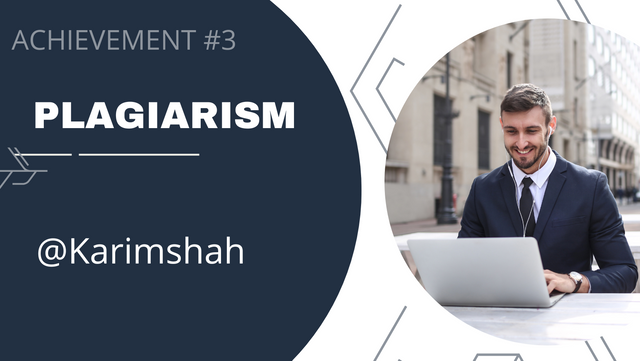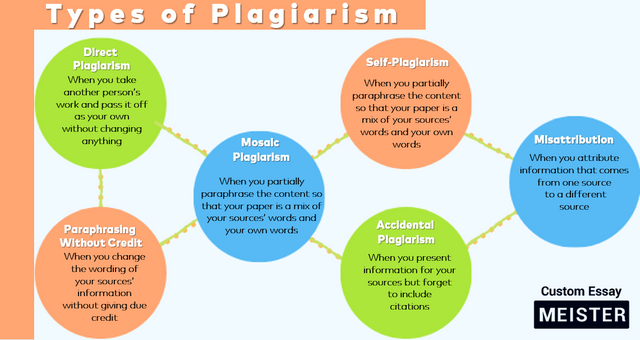Achievement 3 by @karimshah Task : Content Etiquette
Achievement 3
ASSALAMUALIKUM :
Hello everyone , i hope everyone is enjoying your good life with your family as well as doing your daaily activities in a good way.
my today post is my achievement 3 which is about plagiarism and ettiquites of working in steemit or any other bloging and blockchain network.
What is plagiarism:
Plagiarism is the act of using someone else's work or ideas as your own without giving proper credit . It can be as simple as copying & pasting text from a source without citation or as complex as presenting someone else's original idea as your own . In essence , plagiarism is intellectual theft & is considered a serious offense in academic and professional settings.
Explanation with examples and different types of plagiarism:
Plagiarism is when someone uses someone else's work , ideas , or words without giving credit to the original source. It can take many forms, ranging from outright copying to paraphrasing without attribution. Here are a few examples:
Academic Plagiarism:
Academic plagiarism is using someone else's work or ideas without proper attribution in an academic context. This can occur in many forms, including:
Copying and Pasting:
A student copies text from a source without citation and pastes it into their assignment. This can be intentional or accidental , but either way , it is still considered plagiarism.
Paraphrasing without Attribution:
A student reads a passage & then rewrites it in their own words , but without giving proper credit to the original source. This is also considered plagiarism because it is still using someone else's ideas without acknowledging them.
Group Work:
A group of students collaborates on an assignment , but one member contributes little or nothing & then takes credit for the entire project. This is plagiarism because the student is presenting someone else's work as their own.
Self-Plagiarism:
A student submits a paper they wrote for another class as if it were original work. This is also plagiarism because the student is presenting the same work as new without acknowledging that it was previously submitted.
Journalistic Plagiarism:
Journalistic plagiarism is using someone else's work or ideas without proper attribution in journalism . This can occur in many forms , including:
Copying and Pasting:
A journalist copies text from a source without citation & uses it in their article. This is still plagiarism , even if the journalist rewords the text slightly.
Paraphrasing without Attribution:
A journalist reads a story & then rewrites it in their own words without giving Proper credit to the original source. This is also considered plagiarism because it is still using Someone else's ideas without acknowledging them.
Fabrication:
A journalist makes up a story or quotes someone who didn't actually say what they are quoted as saying. This is considered plagiarism because the journalist is presenting someone else's work or words as their own.
Creative Plagiarism:
Creative plagiarism is using someone else 's work or ideas without proper attribution in Creative endeavors , such as writing , art or music. This can occur in many forms , including:
Copying and Pasting:
An artist copies an image or design from another artist without giving proper credit. This is still plagiarism , even if the artist changes the image slightly.
Paraphrasing without Attribution:
A writer reads a story & then writes a similar story without giving proper credit to the original source. This is also considered plagiarism because it is still using someone else's ideas without acknowledging them.
Sampling:
A musician samples a portion of another musician's song without giving proper credit or permission. This is considered plagiarism Because the musician is using someone else' s work without acknowledging them.
In conclusion , plagiarism is a serious offense that can occur in many forms in various contexts. It is important to always give proper credit to the original source of any work or ideas that Are not your own. This includes citing sources , using quotation marks for direct quotes , & seeking permission for any use of someone else's work.
how to avoid plagiarism ?
Avoiding plagiarism requires taking deliberate steps to ensure that any work you produce is original & properly cites any sources used. Here are some tips on how to avoid plagiarism:
Understand what plagiarism is:
Make sure you understand the definition of plagiarism & how it can occur. This will help you recognize when you are at risk of plagiarizing & take appropriate steps to prevent it.
Use your own words:
When writing or creating content, use your own words & ideas. Avoid copying & pasting from other sources , even if you reword the text slightly.
Cite your sources:
Whenever you use information from a source , make sure to cite it properly. This includes direct quotes, paraphrasing & summarizing . The citation should include the author's name , the title of the workz & the publication information.
Use plagiarism checkers:
Use online plagiarism checkers to review your work before submission. These tools can help you identify any instances of potential plagiarism & make necessary changes.
Keep track of your sources:
Keep track of all sources you use for research or inspiration . This will help you properly cite them later & prevent accidental plagiarism.
Understand the rules:
Make sure you understand the rules & guidelines for citation & plagiarism at your school university or workplace. Different institutions may have different standards for what constitutes plagiarism & how it should be avoided.
Seek help:
If you are unsure about how to avoid plagiarism , seek help from a teacher, librarian , or writing center. They can provide guidance & resources to help you properly cite sources & avoid plagiarism.
By following these steps, you can ensure that any work you produce is original , properly cited , and free of plagiarism.
now lets talk about citation.
what is citation?
definition :
A citation is a reference to a published or unpublished source that has been used in a research paper, article, or other written work. It provides the reader with enough information to locate the original source of the information cited in the text.
Example of citation:
example 1. lets talk about ,effect of workout on health.
"Being physically active can improve your brain health, help manage weight, reduce the risk of disease, strengthen bones and muscles, and improve your ability to do everyday activities".source
example 2. effect of fruits on health:
"Fruits are an excellent source of essential vitamins and minerals, and they are high in fiber. Fruits also provide a wide range of health-boosting antioxidants, including flavonoids.
Eating a diet high in fruits and vegetables can reduce a person’s risk of developing heart disease, cancer, inflammation, and diabetes. Citrus fruits and berries may be especially powerful for preventing disease."source


Thank you for completing the achievement 3 task, please complete two examples of how to make a citation so that it can be verified.
@radjsalman thankyou sir for informing ..
I added the citation and its examples.
please check it now.
Thank you for completing the Achievement 3 task, please proceed to the next achievement task.
Rate 2
Hello
@karimshah
I am the moderator of the Incredible India community
I love to welcome you to our community. As I can see you have shared some awesome photographs and our community is based on art and culture.
So it would be our pleasure to have you in our community with many more great photographs.
Our discord:- Meraindia discord link
Regards,
@piya3 (moderator)
Incredible India community
Good achievement
thankyou